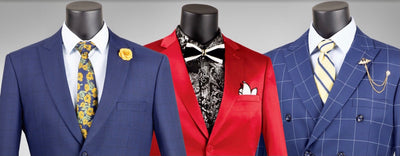Men Suits Brief History
In clothing, a suit is a set of garments made from the same cloth, usually consisting of at least a jacket and trousers. Lounge suits (also known as business suits when sober in color and style), which originated in Britain as country wear, are the most common style of Western suit.
The variations in design, cut, and cloth, such as two- and three-piece, or single- and double-breasted, determine the social and work suitability of the garment. Often, suits are worn, as is traditional, with a collared shirt and necktie. Until around the 1960s, as with all men's clothes, a hat would have been also worn when the wearer was outdoors. Suits also come with different numbers of pieces: a two-piece suit has a jacket and the trousers; a three-piece adds a waistcoat (known as a vest in North America); further pieces might include a flat cap made from the same cloth.
Originally, as with most clothes, a tailor made the suit from his client's selected cloth; these are now often known as bespoke suits. The suit was custom made to the measurements, taste, and style of the man. Since the Industrial Revolution, most suits are mass-produced, and, as such, are sold as ready-to-wear garments (though alteration by a tailor prior to wearing is common).
The current styles were founded in the industrial revolution during the late 18th century that sharply changed the elaborately embroidered and jeweled formal clothing into the simpler clothing of the British Regency period, which gradually evolved to the stark formality of the Victorian era. It was in the search for more comfort that the loosening of rules gave rise in the late 19th century to the modern lounge suit.
Throughout the 20th and 21st centuries, Italy has been a leader in the design of men's suits. The slim fitting suits developed in the 1960s were widely imitated by the mod subculture, and underwent a large scale revival during the late 2000s to mid 2010s . Due to the humid climate, Italian suits are frequently made in shades of light grey, sand or stone to reflect the sunlight. Typical fabrics include lightweight flannel, a wool and mohair blend, and linen or chino cloth for hot weather.
Because wearing a suit conveys a respectable image, many people wear suits during the job interview process. An interview suit is usually a conservative style, and often made of blue or grey fabric. Interview suits are frequently composed of wool or wool-blend fabric, with a solid or pin stripe pattern.
For many men who do not wear suits for work, particularly in Western society, wearing a suit is reserved for special occasions, such as Church Service, weddings, funerals and other formal social events.

